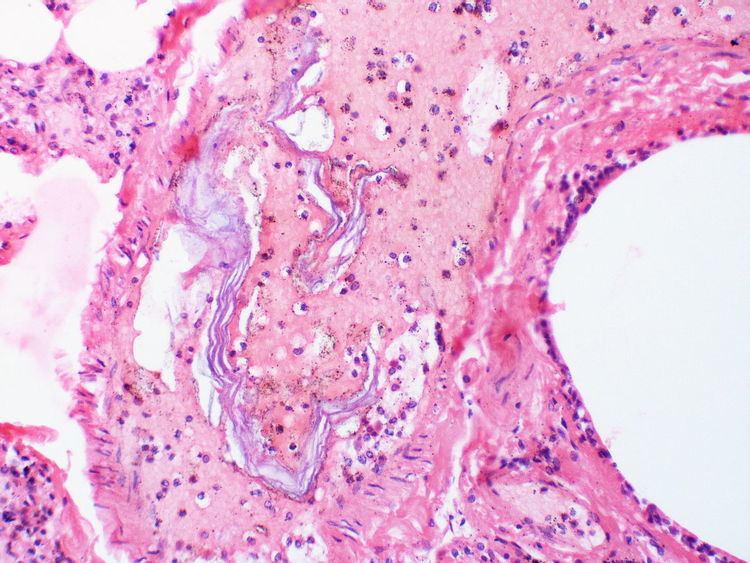Specialty obstetrics ICD-9-CM 673.1 eMedicine med/122 | ICD-10 O88.1 DiseasesDB 574 MeSH D004619 | |
 | ||
An amniotic fluid embolism (AFE) is a rare childbirth (obstetric) emergency in which amniotic fluid, fetal cells, hair, or other debris enters the mother's blood stream via the placental bed of the uterus and triggers an allergic-like reaction. This reaction then results in cardiorespiratory (heart and lung) collapse and massive hemorrhaging (coagulopathy). It was first formally characterized in 1941. While it is rare (between 1 in 8,000 and 1 in 80,000 deliveries), the high mortality makes it the fifth most common cause of maternal mortality in the world, in some estimates.
Contents
Presentation
The condition is rare (between 1 in 8,000 and 1 in 80,000 deliveries).
When the fluid and fetal cells enter the maternal pulmonary circulation there is profound respiratory failure with deep cyanosis and cardiovascular shock followed by convulsions and profound coma, in a first and second phase.
First phase
In the first phase, the patient experiences acute shortness of breath and hypotension. This rapidly progresses to cardiac failure leading to a reduction of perfusion to the heart and lungs. This may be accompanied by other "premonitory symptoms" such as shivering, coughing, vomiting, and an unpleasant taste in the mouth. Not long after this stage the patient will lose consciousness due to circulatory collapse. While previously believed to have a maternal mortality rate of 60-80%, more recently it has been reported at 26.4%.
Second phase
About 40 percent of the initial survivors will pass onto the hemorrhagic phase. The blood loses its ability to clot and there is excessive bleeding. Collapse of the cardiovascular system leads to fetal distress and death unless the child is delivered swiftly.
Causes
It is thought that this condition results from amniotic fluid entering the maternal circulation via the uterine veins, which then has either a direct effect on the lungs, or triggers an immune response in the mother.
In order for amniotic fluid to enter the maternal circulation, there are three prerequisites:
Although exposure to fetal tissue is common and thus finding fetal tissue within the maternal circulation is not significant, in a small percentage of women this exposure leads to a complex chain of events resulting in collapse and death.
There is some evidence that AFE may be associated with abdominal trauma or amniocentesis. A 2006 study showed that the use of drugs to induce labor, such as misoprostol, nearly doubled the risk of AFE. A maternal age of 35 years or older, caesarean or instrumental vaginal delivery, polyhydramnios, cervical laceration or uterine rupture, placenta previa or abruption, eclampsia, and fetal distress were also associated with an increased risk.
Treatment
There is no specific treatment for amniotic fluid embolism, and initial emergency management is the same as for any other cause of sudden maternal collapse - with cardiovascular and respiratory resuscitation and correction of the coagulopathy. However, newer research with animal models suggest that significant embolism of any material is followed by platelet degranulation, pulmonary hypertension due to serotonin and thromboxane, and systemic hypotension due to vagal stimulation. Armed with this knowledge, several women have survived and regained a pulse immediately after ondansetron, metoclopramide, atropine, and ketorolac were administered. One emergency intervention which has been applied is an immediate caesarean section.
Recurrence
According to review published in 2009, a total of 9 cases of successful pregnancy following AFE, with no instances of recurrent AFE, have been reported in the literature. Therefore, although the available information is limited, the current evidence suggests that AFE is not a recurrent disease.
